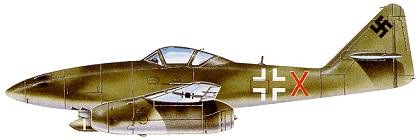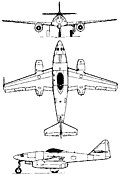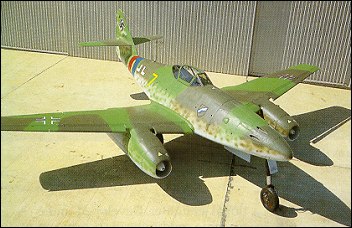|
| What would have been the outcome of the war in Europe if in 1940 the potential of Messerschmitt's Project 1065 had been appreciated by high authority? If a crash programme had been originated to put this turbojet-powered aircraft into service at a much earlier date, would the Luftwaffe have regained the initiative of the first two years of World War II?
Unfortunately the answers are not clear cut and there is no space here to discuss the pros and cons. It must suffice that the Me 262 (as the P.1065 became designated) was the world's first turbojet-powered aircraft to enter operational service - at Juvincourt, France on 10 July 1944. By then, however, the end of hostilities in Europe was only ten months away: the lack of a real plan for the deployment of these aircraft and the
inadequacy of tactics to gain full benefit of their' speed advantage could not be rectified in so short a time - especially under the chaotic conditions existing in Germany and with dwindling supplies of fuel .
Messerschmitt's P.1065 design had originated as early as 1938 when the Reichsluftfahrtministerium had requested the company to design a twin-engined fighter able to utilise the new turbojet engines being developed in Germany. After inspection of the mock-up, three prototypes were ordered on 1 June 1940. But because the engines to power the Me 262 had not been developed sufficiently, the first prototype flew initially with piston engines. It was not until 18 July 1942 that the first flight with all-turbojet power was recorded. (The Heinkel 280, which did not enter production, had flown before the Me 262, on 2 April 1941, so becoming the world's first twin-engined jet.)
Of conventional all-metal stressed-skin construction, the wing had moderate sweepback, long-span ailerons, trailing-edge flaps, and full-span automatic leading-edge slots. The engines were mounted beneath the wing to preclude a complex wing-spar structure and the landing gear was of retractable tailwheel type. The fifth prototype introduced a non-retractable nosewheel unit and the sixth was the first to have a fully retractable tricycle-type landing gear.
First major version was the Me 262A-1a Schwalbe (Swallow) interceptor, armed with four 30mm MK 108 cannon mounted in the nose. It was powered by two 8.825kN Junkers Jumo 109-004B-1 eight-stage axial-flow turbo-jets. A number of variants were built with differing armament. The other major version was the Me 262A-2a Sturmvogel (Stormbird) bomber. This was produced at the insistence of Adolf Hitler - a decision which caused considerable overall production delays. It carried, in addition to the standard MK 108 armament, one 1,000kg, two 500kg or two 250kg bombs. As with the Schwalbe, there were a number of variants, mainly for armed or unarmed reconnaissance.

| MODEL | Me-262A-1a |
| CREW | 1 |
| ENGINE | 2 x Junkers Jumo 004B-1/-2/-3, 8.82kN |
| WEIGHTS |
| Take-off weight | 6400 kg | 14110 lb |
| Empty weight | 3800 kg | 8378 lb |
| DIMENSIONS |
| Wingspan | 12.48 m | 41 ft 11 in |
| Length | 10.6 m | 35 ft 9 in |
| Height | 3.84 m | 13 ft 7 in |
| Wing area | 21.7 m2 | 233.58 sq ft |
| PERFORMANCE |
| Max. speed | 870 km/h | 541 mph |
| Ceiling | 11450 m | 37550 ft |
| Range | 1050 km | 652 miles |
| ARMAMENT | 4 x 30mm cannons |
 | A three-view drawing (1667 x 1123) |
| Oldgunny, e-mail, 30.04.2016 23:30 Mick; whoever told you that the Atomic Bomb was never intended to be used against Germany was grossly misinformed. The Einstein–Szilárd letter, written by Leó Szilárd with the help of fellow Hungarian physicists Edward Teller and Eugene Wigner and signed by Albert Einstein, was sent to the United States President Franklin D. Roosevelt on August 2, 1939, (over 2 years before Japan attacked the US). The letter warned that Germany was working on the design of a Nuclear reactor, and was also looking into the possibility of a weapon using similar technology. Roosevelt decided that the letter required action, and authorized the creation of the "Advisory Committee on Uranium," chaired by Lyman Briggs. Once America got into the war, the development of an Atomic bomb, to counter the perceived German efforts in that field, got into high gear. In fact, when Germany surrendered on 8 May 1945, several of the scientists working on the project approached Oppenheimer, (the lead scientist), and asked if the project would be stopped, now that Germany, the intended target, was no longer a threat. They were told that the project would continue for possible use against Japan.
"Fallout" was not a factor in the decision to use a Nuclear weapon in 1945; mainly because, amazing as it sounds today, the scientists working on the project did not realize the long lasting effects of "Fallout". The reason no Atomic bomb ever fell on the European continent was that the first Atomic bomb was not ready for testing until July 16, 1945; over two months after Germany gave up.
After the war, the US scientists investigating the after effects of the bomb at Hiroshima were surprised and appalled to learn that Nuclear "Fallout" was one of the major effects of the "A' bomb, and not the minor one they had believed it to be. It still took "Operation Crossroads", at Bikini Atoll in mid-1946, to convince US military planners that Nuclear "Fallout" was a major problem when Atomic bombs were used.
That "Old Chestnut" about America not needing to drop "The Bomb" on Japan has been making the rounds for the last 70 years. At the Imperial Cabinet, where Hirohito broke the deadlock and told his ministers to end the war, the main topic of discussion was the possibility of total destruction of all Japanese by the destructive power of America's new "Super" weapon, and not Russia's entry into the war against them. The "Blame America first" crowd has always tried to manipulate history to suit its political agenda! reply | | Ken Bloomhorst, e-mail, 16.02.2016 22:55 I grew up between Wright and Patterson field. I was used to propeller driven aircraft, but one day I heard a strange noise I had never heard before.I looked up in the sky, but couldn't find or see anything. this kept happening for a couple of days, then to my amazement I spotted the German jet. We had captured a Messerschmitt Me 262 and were testing it. I wasn't used toa plane being way ahead of it's sound. reply | | mick, e-mail, 01.02.2016 11:34 The atomic bomb was always meant for Japan, bombing Germany with nuks would have covered Europe in a cloud of radiation fallout & the Allies knew this that's why it never fell on the continent, the bombing of Japan with nukes was purely political as the damage caused to industry was very minimal, they used the bombs to show the world who "allegedly was superior". Japan surrendered not from the nuclear threat but by the threat of Soviet invasion reprisal from occupation of Russia by the Japenese early 1900's. As usual history has been manipulated to suit political agenda's reply | | Oldgunny, e-mail, 09.01.2016 22:38 All of the "what ifs" miss the point. First of all, there would not have been a German Atomic bomb in 1946; the German Atomic Bomb project had failed, (some contend it was sabotaged by the scientists working on the project). Second, the Manhattan Project was not being pursued to Nuke Japan, it was intended for Germany. If Germany had had Me262s in sufficient numbers to drag out the war in Europe for another 4 months, it would have been two German cities who received "Fat Man" and "Little Boy" in early August 1945, not two Japanese cities. The end result would have been the same; Germany's total defeat. reply | |
| | BHH, 19.03.2015 05:41 The free world owes much to the fact that the destiny of such a brilliant airplane was decided by such STUPID people. reply | | Ron, e-mail, 27.01.2015 23:31 "I was a cadet, or you can call me a flight cadet or midshipman one if you want, for the Air Force. I was a fighter pilot at the time. I flew a Me-262. At the time I did not like the idea of this thing called a jet. I thought that it was not safe, and that I was going to kill myself. So I flew into battle, and oh yeah, I was faster than I thought was possible to go. You should have seen the look on those American faces when I walked on it. I nearly killed myself that day, so not to be trifled with not using them. But surprisingly level. I just wanted to share my story. Google Translate it." reply | | Flag Junker, e-mail, 14.02.2014 00:02 Ich war ein Fahnenjunker, oder Sie können mich einen Flug Cadet oder ein Fähnrich, wenn Sie wollen, für die Luftwaffe. Ich war ein Kampfpilot an der Zeit. Ich flog eine Me-262. Zu der Zeit wusste ich nicht, wie die Idee dieses Ding namens ein Jet. Ich dachte, dass es nicht sicher war, und dass ich im Begriff war, mich selbst getötet. Also flog ich in die Schlacht und oh yeah, ich war schneller als ich dachte, war möglich gehen. Sie sollten den Blick auf jene amerikanischen Gesichter sehen sollen, als ich ging sie auf. Ich habe mich fast umgebracht, dass Tag, so dass nicht zu spaßen nicht mit ihnen. Aber erstaunlich Ebene. Ich wollte nur meine Geschichte zu teilen. Google Translate it. reply | | Ron, e-mail, 29.12.2013 09:44 Yes visibility from the cockpit was not the best.
The canopy was fine but the body was so wide and the twin engines on swept wings blocked much of the overall view.
Also the unique shape could be easily identified far off by an adversary. Of course it's virtues far outweighed it's flaws.
Compared against Allied contemporaries like the Bell P-59 and Gloster Meteor, the Me 262 was superlative. The other 2 jets did not have the chops to mix it up with the Schwalbe. reply | | Dalhats Laudzafata Avicena, e-mail, 17.08.2013 18:24 The messerscmitt 262 have poor visibility. reply | | Kitsch, e-mail, 30.06.2013 21:23 Oh please Justin! YOu're almost as deluded as Steinhoff!
Now where could Germany conceivably get enough materials to produce so much Me262s? Even if we accept the ludicriously low number of 80 Me262 in a single engagement could have stopped daytime bombing (which from JG7's experience of launching between 35-50 planes per raid during Feb. of 1945 attested....strategically it still amounts to nothing)
From June 1943- Oct 1944 Messerschmitt was only able to produce no more than 340 airframes, that was before the losses from bombing, accidents, transportation took its toll.
And even according to Adolf Galland's(the guy's been ultra-enthusiastic about Me262 ever since he tried it, but the fact was there was still tons of problems with the Jumo 004 and it was nowhere near operational yet) optimistic "guessing", he would need about 500 of them in order to stop the daytime bombing, this of course does not factor in the fact that there's probably not enough J2 left in the Reich to support such an operation, and even if there were, the lack of experienced pilots, which would be required in order to score a hit within 2 seconds and break away, would have doomed the plan anyways.
Realistically speaking, the fact that Me262 actually manage to enter operational status was no less than a miracle, but to hope that it could have turned the tide...that was beyond dreaming, that was simply fairy tale perpetuated by less discerning minds. reply | | Justin, 16.11.2012 02:58 The Horton 18 was the bigger version and was also stealthy. It was clear then Germany would have a nuke by 1946. if the war could have held out til then the world would be much different. reply | | Justin, 16.11.2012 02:55 Imagine if the Germans had deployed these in great numbers without going over test over test for years until they finally realized that they were losing. Also those two engines were also being used to power the Horton 229. If that wouldn't have taken so long they could've had an even faster jet, stealth, and the cannons it would've created mass destruction! I mean the Horton 18 actually had the distance to reach the US and drop an Nuke! reply | | EDWARD WYDA, e-mail, 25.02.2012 03:04 ONE OF THESE ME 262'S IS AT THE ENTERANCE OF TYNDALL AIR FORCE BASE LOCATED JUST EAST OF PANAMA CITY, FLORIDA... reply | | peter, e-mail, 01.02.2012 15:58 Its all very well speculating what would have happened if this plane had not been delayed, but what if Whittle hadn't been overlooked for years either. There could have been aircraft with Meteor / Vampire performance by 1938 and Canberra type bombers by 1941.
No way would Hitler have risked war with a jet equiped Royal Air Force ( Whittle himself stated he felt he should have done more to persuade the government to adopt the turbojet earlier and have prevented , or at least delayed, World War 2 . No wonder the guy was a nervous wreck ).
Whittle mostly blamed Freeman ( protagonist of the Mosquito) to the extent of calling him a Nazi agent. reply | |
| | Joe Wolf, e-mail, 17.01.2012 09:45 I have read that Adolf Galland taught pilots to hit the brakes on takeoff. He supposedly stood at a spot on the runway to indicate the point to brake to get the tail up and give the horizontal stabilizers some slipstream to work with. I have a very short video of a taildragger Me262 landing. reply | | Raptor lighting 2, e-mail, 25.09.2011 11:50 magnifique ... reply | | Hans, e-mail, 19.07.2011 02:54 What is not stated in the write up is how it came to be that the 262 went from a tail dragger (tail wheel) to a nose wheel configuration. The first test flight could not get the tail unstuck so the aircraft could not take off. Because of the jet engine they were missing the propwash that helped lift the tail. Major problem! During a meeting on what could be done to solve this problem a technician suggested that if they get the aircraft going down the runway and then at the appropriate time hit the brakes to create a nose down moment (tail up) and then take off. It worked on the first few test flights until they reconfigured the aircraft with a nose wheel and got the center of gravity forward of the main gear. This story was told to me by a boss of mine, Richard Hadcock who met one of the pilots after the war at a conference. It was also confirmed to me personally by Dr. Hans Von Ohein, the inventor of the axial flow compressor, better known as the jet engine. He invented it as a grad student and told the story about how hard it was to keep the turbine lit. He decided that he needed a fuel with the highest combustion range and realized that that was hydrogen. He successfully demonstrated the engine using hydrogen. Sir Ralph Whittle developed the radial flow compressor concept but because of the large frontal area it was not as suitable for aircraft. As it turns out Dr. Von Ohein and Sir Whittle became good friends after the war. Dr. Von Ohein as I understand it got not one penny in royalties for the invention of the jet engine. He worked for many years at Wright Patterson Air Force base in the propulsion department. A very decent and brilliant man who I met several times and liked very much. reply | | Glenn Florence, e-mail, 07.06.2011 01:00 In researching the ME 262, what impressed me then and still is the german engineering successes, because of war conditions at the time and limited service facilities, the ME 262's jet engines could be removed (in the field) and replaced in one hour's time! AMAZING !!! reply | | Glenn Florence, e-mail, 07.06.2011 00:59 In researching the ME 262, what impressed me then and still is the german engineering successes, because of war conditions at the time and limited service facilities, the ME 262's jet engines could be removed (in the field) and replaced in one hour's time! AMAZING !!! reply | | OC Tester, e-mail, 09.04.2011 15:03 Note of interest: The 262 I saw on display at the WPAFB museum had the monstrous (105mm?!) cannon jutting out of the nose, offset from center. Said cannon was for 'tank destruction', ala America's A10 Warthog. The display placard noted that Herman Goering, when captured, wanted to be sure that his peers on the allied side KNEW that he wasn't so effing stupid as to put the cannon on the plane. That the order to put it there came straight from the madman himself, Der Fuhrer AH himself. Seemed quite humorous. reply |
|
Do you have any comments?
|
| 
COMPANY
PROFILE
All the World's Rotorcraft
|








